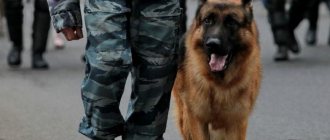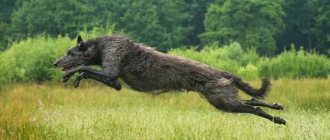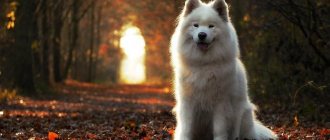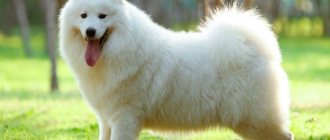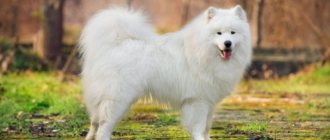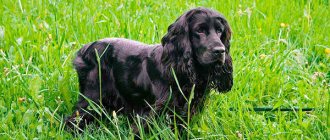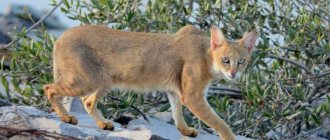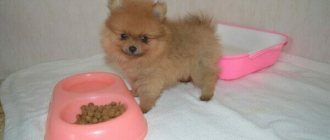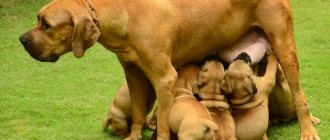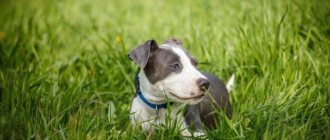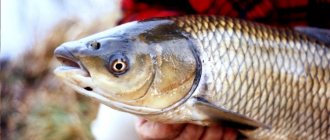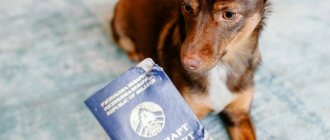History of the origin of the Samoyed Laika
It is not known for certain, but a hybrid of an arctic fox and a polar wolf is considered to be a full-fledged ancestor of the dog. Pets domesticated by the people of the north helped herd deer and hunt large wild animals, bears and walruses.
They were used as sled dogs and were wonderful nannies for babies, protecting and warming them during the northern polar nights. The white color gave the initial name to smart dogs; the local population called them “squirrels.” So the wild animal became a true friend of man.
One of the oldest breeds was formed in the harsh climate of the Russian North, where the Nenets now live. For more than 3 thousand years she lived and hunted side by side with people, remaining unchanged for a long time. Looking at the Samoyed husky in the photo, we can assume that it looked the same many centuries ago.
Character and habits of Samoyeds
The standard clearly defines not only the appearance, but also the behavior of representatives of the breed. Samoyeds should not be distrustful, aggressive or cowardly. These dogs have a soft, reserved character and developed intelligence. They are loyal, attached to their owner, but friendly with all people and pets. Breeders consider the Samoyed to be an ideal pet. This is a loyal companion, suitable for any person who will give him enough attention. By nature, Samoyeds are flexible, affectionate, and friendly. Very sociable, friendly, get to know other people and dogs. Sometimes they are even overly gullible.
They become very attached to the owner and his family members and try to follow him everywhere; they do not like to be alone. Therefore, you cannot keep this dog in an enclosure or on a chain. They do not have conflicts, since they have been accustomed to working in a team since ancient times. But if necessary, they will always repel any opponent, they are brave and strong. They are delicate in behavior and will never impose their company. Even adult Samoyeds are very cheerful, playful, and love to run after the ball.
In America they are called “feel good dogs.” Samoyeds love children very much. They will play with the child, protect him, and take care of him. Since ancient times, these dogs have been nannies for northern peoples, warming babies at night with their warmth. Such a pet will never offend a child and will tolerate his pranks. The peculiarity of the Samoyed Laika is its attentiveness, calmness and adequate behavior. Therefore, she can become a guide for the blind, a companion for an elderly person. This dog is sensitive to changes in the owner’s mood and well-being.
Education and training
Samoyeds are easy to train. They are smart, obedient, not stubborn. But due to the high intelligence, independence and curiosity of these dogs, there are several features in training:
- they will quickly get bored with monotony, so training should be original and interesting;
- this is a pack animal, so from an early age you need to gain authority and show who is boss in the house;
- success can be achieved only by showing love and patience; rudeness and violence in raising a Samoyed are unacceptable;
- for incorrect behavior and pranks you need to punish, to do this, take the dog by the withers, shake it and press it to the floor, as the leader of the pack does.
You need to raise a puppy from the first days of his appearance in the house. Samoyeds also need proper and timely socialization. It is important to accustom your pet to its name, place in the house, leash and collar. It is necessary to familiarize with the street, loud sounds, cars. From the age of 3 months, the baby can be taught the basic commands: “come to me”, “sit”, “no”, “place”, “near”. Additionally, it is recommended to take a general training course and visit dog parks to give your pet physical exercise. It is easy to teach these dogs freestyle, agility and other sports. Video about the character traits and upbringing of these dogs:
Versions about the origin of the name
There are two known versions of where the name came from - Samoyeds. It is important to make a reservation right away: it has nothing to do with the gastronomic preferences of this animal. The northern ethnic group - the Nenets, belong to the tribes of the Samoyed group. “Saam Jedna”, “self-eater” is their original name. The definition of nationality became the basis of the Russian name for the breed.
According to the second version, unconfirmed: White dogs harnessed to a sleigh merged with the background of the snow-white desert. They were practically invisible. From a distance it seemed as if the sleigh was “moving on its own.”
Boys and girls: what are the differences?
It is quite easy to distinguish a female from a male by two characteristics: collar and body type.
Males have a truly luxurious collar and, in general, the breed characteristics are more pronounced. Females have a more compact and graceful physique.
There are also behavioral differences.
NOTE!
For example, females are more suitable for family, calm people, as they have a more flexible disposition and love to spend time with children.
Males, on the contrary, gravitate towards active pastime and have a more independent disposition, which means he can become an excellent companion for an avid traveler.
Spread around the world
Having left their habitat, closed for centuries from prying eyes, the first dogs of a breed not yet known to anyone appeared in 1890 in Great Britain.
The famous explorer of polar latitudes, captain of the Royal Navy Robert Scott demonstrated to the whole world the endurance of Samoyeds. Previously, he used these dogs to transport heavy loads over long distances.
- In 1909, the Samoyed Club was founded in England, where a breed standard was established.
- And since then, breeders in many countries have become the heart and soul of the world of dogs of this species. Thanks to them, white “wolves” spread throughout the world.
- The number of aborigines of the original Russian northern breed, the Samoyed Laika, has practically disappeared since 1930.
- Having made a difficult journey, undeservedly forgotten, they nevertheless appeared in Russia. Samoyeds were brought from Denmark in 1989.
Training
Success in training a stubborn “northerner” can only be achieved by the one whom the dog recognizes as the leader. The puppy needs to prove leadership as soon as he gets to his new home.
Attention: you cannot hit a Samoyed dog! Such actions will offend the proud pet, and he will stop obeying the offender.
You can act by imitating some semblance of the life of a wolf pack. To do this, you need to follow a few simple rules:
- feed the puppy only after people have eaten;
- do not allow anyone to leave the designated area or enclosure without permission;
- The owner must enter the house first;
- offenses cannot be ignored. It is permissible to punish the dog in the following way: lightly shake the withers (without causing pain) or press the muzzle to the floor.
These principles will be easily accepted by the pet, because this is how hierarchy is built in the animal world.
The dog must follow the rules of behavior in the apartment. From the first days you need to prohibit him from climbing into bed or begging for food. Samoyeds are extremely smart and cunning, they instantly recognize the “weak link” among family members and begin to skillfully manipulate them.
From the age of three months, it is worth teaching the puppy basic commands: “come to me”, “no”, “fu”, “place”, “near” and others. You need to work on tasks gradually, mastering skills one at a time.
Thanks to its keen mind, the Samoyed Laika is easy to train, but some difficulties may arise. They are due to the fact that this breed is genetically endowed with the ability to make independent decisions and the desire to rely solely on its own strength.
You can change the natural qualities by getting the dog interested. For this purpose, training conducted in a playful manner, with frequent changes in the type of activity, is suitable. Then Samoyeds will practice commands with pleasure and quickly master the necessary skills. The dog should always feel love and respect from its owner.
Appearance
The Samoyed is a medium-sized breed. According to the standards, the size of an adult dog corresponds to:
- Male – has a mass of 25-30 kg, height at withers 51-56 cm;
- Bitch – weight ranges from 17-25 kg, at the withers grows to 46-51 cm.
A strong and muscular dog, it is proportionally built, despite the fact that the body is much longer than the height at the withers. Standards are an undeniable thing, so the price of a Samoyed husky depends on them.
A Samoyed puppy looks like a snow-white bear cub. As an adult, he resembles a polar wolf. This is especially noticeable when the tail is high and thrown over the back when moving, and in a relaxed state is lowered down.
Life expectancy and diseases
The average lifespan of a Samoyed is 12–13 years.
Main diseases:
- Cataract.
- Hip dysplasia.
- Diabetes.
- Pigmentation of the nasal lobe.
- Retinal atrophy.
- Deafness.
Thick long hair
The lush, dense coat is made up of a hard outer coat and a thick undercoat.
- A chic fur collar hides a medium-length curved neck and powerful shoulders.
- And beautiful “pants” adorn the dog’s strong hips and tail.
- On the limbs themselves and on the head, the hair is not so long.
- The hair on the ears is short on the outside and covered with fur on the inside.
Maintenance and care
The main thing in caring for a Samoyed is to properly comb their coat. But such a procedure is not as complicated as it might seem, although the amount of hair in Samoyed huskies is large, but with regular combing, the owners will not have problems with tangling the hair.
Samoyeds are combed using the following method:
- start from the bottom of the body, bend all the hair upward, and comb in the direction of its growth;
- tangled areas need to be combed out especially carefully, trying not to hurt the dog;
- In order for the appearance of the Samoyed husky to be excellent, after completing the combing procedure, a regular comb is run through the dog’s fur against its growth. This is necessary to lift the undercoat.
It is forbidden to shave or trim the hair of Samoyeds, even if the owner thinks that his pet is too hot. The medium-length coat of these pets serves as a natural protection against cold and heat, and also protects the skin from sunburn. For hygiene purposes, the hair in the area of the anus, in the upper part of the limbs, and between the paw pads is trimmed.
Samoyeds begin to shed in spring and autumn, and the old undercoat is replaced with a new one. During this period, there may be a lot of fur in the house, but careful brushing during this period can reduce the amount of “fluff” on the floor.
Bathing these dogs is quite difficult due to the large amount of hair and undercoat. It is also difficult to dry his coat afterwards, so dry shampoos are often used to wash these dogs.
These dogs should be walked frequently due to their energetic nature. Since the dogs' fur is too thick, it is better not to keep Samoyeds in hot climates. It is better to keep Samoyeds in the northern zone, in Siberia, the Urals and in regions with a similar cool climate.
Feeding
Feeding is very important in the life of these dogs - not only the appearance of the Samoyed, but also its health and immune system depends on balanced food. Feeding varies between puppies and adult dogs
How and what to feed puppies?
In the first weeks of their life, the quantity and quality of food should be the same as that given by the breeder. At the same time, the breeder usually talks in detail about the products that were in the diet of the little Samoyed.
When a puppy is brought into the house, you should not immediately start feeding it new food - the dog must adapt to the new living conditions, to the new owners. And often even other drinking water can cause stomach upset in a small dog.
A purchased puppy is usually at least 2.5 months old; by this time, breeders have given all the dog’s vaccinations required by age. The diet of a three-month-old puppy is up to 5 times a day. The daily amount of food for such a baby is no more than 6% of his total body weight. If the diet includes ready-made commercial food, then you should follow the instructions on the packaging.
At 5 months, babies are transferred to 3 meals a day. After six months, sea fish (salmon, salmon, chum salmon) appear in the puppies’ diet. And by the age of 7 months, the puppies’ feeding regime is two meals a day (morning and evening).
Both puppies and adults should be fed only after preliminary exercise - walks, games or some kind of work. The food bowl is removed after feeding, but drinking water should always be accessible and clean.
Adult Samoyeds are fed dry and wet food from premium brands; they must be hypoallergenic and grain-free. The diet should also include natural products:
- meat and offal of animals and poultry;
- fermented milk products (cottage cheese, kefir, fermented baked milk);
- fatty sea fish;
- vegetables (cabbage, zucchini, pumpkin, green beans);
- fruits (citrus fruits and grapes cannot be given).
Education and training
When communicating with Samoyeds, you should not use brute force or shouting, as these dogs are proud and self-loving.
Therefore, rudeness cannot achieve anything from Samoyeds; it can only make things worse. Training is based on the rules that are laid down in a wolf or dog pack. The elders in it:
- eat first, so in a family the owners eat first, and then feed the pets;
- they enter the house first, so dogs enter the premises after their owners;
- the younger ones should not get in the way, so the Samoyed’s place is in a part of the house where the Samoyed will not disturb with its presence.
Samoyed training begins at 3 months, during which time they are taught to be obedient. First, the puppies are taught to follow certain commands given by the owner. The dogs then take an exam and receive a corresponding document.
In the future, Samoyeds can be trained to:
- search;
- rescue;
- trace;
- security types of service.
The training course should be conducted with an instructor who will tell and show how to train Samoyeds. The method of training depends on the character of the dog.
Head
The different head shapes divide the breed into 3 types: fox, wolf and bear.
Fox type
- Small head;
- The muzzle is pointed;
- Ears are sharp.
Wolf type
- The head is round;
- The ears are rounded;
- The nose is extended.
Bearish type
- The head and ears are wolf-type;
- But the muzzle is short.
The almond-shaped eyes are deep and wide-set, slanted and slightly cunning. Definitely black. Another prerequisite for the purity of the breed are black lips and nose.
Animal care
Its extraordinary coat requires careful combing once every 7 days, and during seasonal molting - every other day, using a special brush. The fur has self-cleaning properties, so you can wash your pet once every 3 months.
In addition, you need to pay attention to:
- Eyes and ears – wipe with a damp cloth twice a week;
- For teeth – brush once a week;
- Sleeping place - it should be in a cool room;
- Cooling in hot weather - a swimming pool or a bathtub with water in the yard will solve this problem.
Dogs require a lot of attention, love, care, and patience. The animal needs space to move, so it cannot be kept in a small apartment or locked indoors for a long time.
From lack of attention, the animal will begin to act out or, on the contrary, become depressed. A bored dog will bark and howl constantly. A private house with a large yard is ideal conditions for an active lifestyle for a pet.
What to feed and what shampoo to wash a Samoyed dog so that its coat is white and fluffy?
The beautiful coat of the Samoyed is believed to have self-cleaning properties. It always remains white without washing. This is due to the fact that the hard hairs are impregnated with lubricant, and when dirt gets on them, it simply flows off. This feature persists throughout the animal’s life if you do not wash it too often.
But sometimes the owners of such dogs notice that the pet’s snow-white coat begins to turn yellow. This usually happens due to insufficient or improper care:
- the undercoat is difficult to comb out, causing the fur to change color on the back or near the mouth due to saliva secretion
- Excessive amount of protein(s) in the feed
- presence of worms
- pregnancy or lactation
- gastrointestinal and infectious diseases
- disturbance in the body's metabolic processes
After a thorough examination and identification of the reasons for the color change, they need to be eliminated and more attention should be paid to caring for your pet.
Samoyed bathing
According to experts, it is enough to wash the Samoyed twice a year. As a rule, this is done only to rid the Samoyed of foreign odors that permeate its fur. And to keep the coat clean, it is quite enough to simply brush the dog on a regular basis. As mentioned above, this must be done at least twice a week, and during molting, the procedure must be carried out daily.
In case of severe contamination (for example, after walking in rainy weather), it is recommended to wash off the dirt from the animal without using shampoo, just with running water. But show dogs, as a rule, are washed every two weeks so that their coat does not lose its shine and luster.
Basic recommendations for bathing a Samoyed dog:
- Wash your pet with shampoo for white dogs. Such products have whitening and super-cleaning properties. Additionally, use a conditioner or moisturizing mask on the coat
- Since thick hair makes the bathing process quite labor-intensive and difficult, dry shampoo is sometimes allowed
- rinse off the detergent very thoroughly with warm water, avoiding getting it into the animal’s eyes and ears
- When blow-drying, comb the coat against the grain with a wide-tooth comb.
- Using a suede mitten, carefully smooth the fur in the direction of growth - this will give the fur coat additional shine
In addition, to maintain the whiteness of the coat of the magnificent Samoyed husky, it is extremely important to follow the correct diet of its diet. Breeders advise feeding northern dogs with specialized premium dry or wet food, as they contain minerals and vitamins necessary for the animal.
Feeding the Samoyed
During the active growth of the animal (up to 9 months), many veterinarians recommend sticking to natural feeding. The following requirements must be taken into account.
You can't feed your dog:
- chocolate and other sweets
- baking
- chicken and pork bones
- eggs
- lamb
- beets, potatoes and carrots
- milk
- raw meat (it needs to be either boiled or doused with boiling water)
Recommended for feeding:
- beef (steamed or minced)
- offal (boiled only)
- lean raw fish without bones (frozen)
- fermented milk products (they are also required when feeding dry food)
- buckwheat or rice porridge
- cabbage, greens, zucchini, cucumbers, bell peppers, bananas, apples
- chicken fillet (frozen, slightly thawed) – several times a month
- turkey, rabbit (boneless)
Do not forget that with natural feeding it is necessary to give additional vitamins and minerals, and the dog should be fed after a walk.
Samoyed dog food
Due attention should be paid to the dog's nutrition. The breeder's advice on what food to choose will come to the rescue. Of course, it must be complete and balanced, from a trusted manufacturer, super premium, with a high protein content.
In addition, the diet of an adult Samoyed includes:
- 30% – lean meat (boiled or raw);
- 30% – cottage cheese, kefir, natural yogurt;
- 20% – fruits, vegetables, cereals, offal;
- 20% – boiled sea fish without bones.
As a treat you can use: Cheese, rye crackers without flavor enhancers, sugar seeds. Exclude: Bones, fatty meats, smoked meats, baked goods, sweets, chocolate, beans, potatoes, eggs. Limit: Pasta, carrots, milk.
- Puppies from 2 to 4 months are fed 4-5 times a day, and by the age of one year they are fed 2 meals a day.
- An adult dog should be fed strictly 2 times a day.
- To prevent excess weight, it is better after a walk.
Price
The price of puppies with a pedigree depends on which class it belongs to:
- pet - class - dogs of this class can be beloved pets, but do not participate in exhibitions and are not suitable for breeding. Their cost is 10,000-20,000 rubles;
- breed class - dogs of this class are suitable for breeding, their cost is 250,000-35,000 rubles;
- show class - Samoyeds of this class are 100% purebred, their pedigree includes only titled ancestors, such dogs are regularly taken to the most prestigious exhibitions, where they are able to receive first places. Their cost is 35,000-65,000 rubles.
And it should be remembered that these active, intelligent and friendly dogs are perfect for equally active owners who love dogs and are ready to spend almost all the time next to them.
Raising a Samoyed Laika
Puppies are quite willful creatures and their disobedience must be stopped immediately. By excessively suppressing the will of the Samoyed, you will instill stubbornness in him. This breed is quite smart.
If you find an approach to it, show not only strictness, but also praise and encouragement, this will simplify the process - the puppy will grow into an obedient, controllable dog.
How to name?
When choosing a suitable nickname for a Samoyed husky puppy, you can focus on both its external features and character. Quite popular variants of names here include Sunny, Sammi (another name for Samoyeds), Whitey, Belka (Belek, Belyash), Snezhok (Snezhka, Snezhinka), Shuga (Sugar), Snowdy, Snow. Other common name options are Blanc (Bianca, Blanca), Alba (Albert, Albo), Salt, Zephyr, Pearl, Ice, Frozy, Cloud, Angie (Angel), Crystal (Christa).
A Samoyed Spitz boy can be called Cosmos, Star, Prime, Grand, Bright, Titan, Atlant, Boeing. Playful and mischievous puppies are often given the following nicknames: Tyson, Fayt, Game, Play, Fly, Casper, Charlie, Dexter, Joy, Brivi.
Nicknames that are consonant with the names of ancient deities and mythical characters are suitable for dogs of this breed. Examples here include the following options: Zeus, Hermes, Mars, Uranus, Hercules, Argo, Pegasus, Sphinx, Orpheus, Hephaestus, Theseus, Jason. For girls of the Samoyed breed, the following names from the proposed themes are suitable: Nymph, Venus, Athena, Hera, Vesta, Diana, Shakti, Ariadne, Medea, Calypso.
Very often Samoyed huskies are called by beautiful and euphonious foreign names. The most popular options here are the following nicknames for male puppies: Charlie (Charles), Archie (Archibald), Arthur, Oscar, Tyler, Gordon, Jamie, Jakey, Dexter, Ryan, Edward. The following names are often chosen for female puppies: Gerda, Greta, Margot, Bertha, Emma, Adele, Britney, Evie, Grace, Amelie, Alice, Rose, Darcy, Zena, Giselle, Chloe, Heidi, Aisha, Ivory, Yvette, Vega .
Nicknames associated with the world of secular fashion and the attributes of a glamorous life are also very popular among dog breeders. Examples here include such variant names as: Versace, Prada, Tiffany, Gucci, Dior, Cartier, Cardin, Chanel, Dolce, Chloe, Birkin, Rolex, Bentley. The following nicknames also sound original: Snoopy, Bambi, Shanti, Pretty, Darcy.
Possible diseases
Samoyeds are quite hardy animals and are distinguished by good health. But they also have dog diseases:
- Congenital pathologies of the eyes and hearing organs;
- Allergies;
- Diabetes;
- Arthritis, joint dysplasia;
- Genitourinary infectious diseases;
- Gastrointestinal problems.
Follow the correct diet, care and education methods, have regular checkups with a veterinarian, get routine vaccinations and your pet will live a long, happy life for 15 years.
How to buy a Samoyed puppy
To buy a purebred puppy, you need to contact a good nursery. In Moscow, the price of a dog is 25-80 thousand rubles, depending on the class. A puppy with disabilities can be bought cheaper, but it will not participate in exhibitions. Bear-type dogs are not suitable for use as sled dogs because they have shorter legs. It is necessary to study the living conditions of the animals, the health of the parents, and the pedigree. Puppies must have a veterinary passport and have already received their first vaccinations. When choosing, you need to pay attention to the following characteristics:
- the puppy is cheerful, active, not cowardly;
- a cheerful, interested look;
- the wool is clean, fluffy, without an unpleasant odor;
- eyes and ears without discharge;
- limbs parallel.
From the photographs you can see what the puppies should look like:
Photos of puppies
Puppies
Interesting videos give a complete description of dogs of this breed:
The Samoyed is a dog ideal for families with children and active people. Smart, cheerful and kind, she becomes very attached to people. With proper upbringing, the pet will become a devoted friend and companion.
Distinctive features
A distinctive feature in the description of the Samoyed husky is intelligence. Having received a command from the owner, he thinks about it for a few seconds, and only then carries it out.
There are other individual features:
- The Samoyed has no dog smell at all;
- On his face you can see the whole range of emotions that he uses to his advantage. The famous “Samoyed smile” is created by the naturally upturned corners of the mouth and the interesting shape of the eyes;
- This is a pack dog and if you have not taken care of the presence of other Samoyeds in his pack, then he will consider you his pack;
- The dog has no aggressive behavior at all. Aggression is considered a breeding defect;
- They don’t like to swim, it’s real stress for them;
- This breed is often kept in private clinics for the mentally ill. There they provide assistance to people with mental disorders;
- They get along well with other pets.
There are several disadvantages, not many of them: Tendency to shedding, for example. An ill-mannered dog may beg for food or openly steal it.
Does not tolerate hot weather well. Living in a small space requires physical activity, so it is not suitable for older people. This breed is not suitable as a guard - the worst thing it can do to an intruder is to lick him to death. But there are other breeds for guard purposes.
Interesting Facts
Samoyeds have the ability to thermoregulate. When it is very cold, they fluff up the fur in a special way, and when it is hot, it seems to hang. Therefore, Samoyeds do not overheat in the heat and do not freeze even in forty-degree frost.
There are black Samoyeds that are not recognized by the breed standard. In appearance, they are exactly the same as their white counterparts, but have a completely black (sometimes with red tan) color.
The freezing instinct is a distinctive feature of Samoyeds. When a person lies down next to the Samoyed and hugs him, the dog freezes and does not move until the owner wakes up. This made Samoyeds excellent warmers. You can even sleep in bed with them, without fear that the dog will toss and turn or get up.
Samoyeds shed twice a year, and in general their hair falls out extremely rarely. That's why people with allergies sometimes get these dogs. In addition, Samoyeds do not have dandruff. All this makes the breed very convenient for a breeder with any experience working with dogs.
Puppy cost
Having firmly decided to buy a puppy, you will ask yourself the question - how much does a Samoyed Husky cost? The cost of puppies depends on:
- Breeding conditions - the nursery where the puppies are kept must value its own reputation and meet all standards;
- Puppy exclusivity - from titled parents they cost more;
- Age of the dog - adult puppies are more expensive than small ones.
Puppies with slight deviations from breed standards can be bought for about 15-20 thousand rubles. Healthy puppies not from the first litter, whose parents have various awards and have bred no healthy offspring, cost from 45 thousand rubles. and higher. Some nurseries have their own websites, so you can purchase a puppy online.
Description of the breed, characteristics
There is a basic standard for the Samoyed Laika breed, which includes a number of requirements for the appearance of these dogs. The description should begin with a description of the torso.
- The height at the withers for males is 56.5-57 cm, for females - 52.5-53 cm, the average weight of Samoyeds is 22-24 kg.
- The length of the body is slightly greater than the height at the withers. Dogs of this breed are tall, but compact and extremely flexible.
- The head is shaped like a wedge and powerful. The ears are erect, shaped like a triangle, of medium height, slightly rounded at the ends, fleshy.
- The limbs are strong and strong, of medium length, the upper part is covered with thick hair.
The lifespan of Samoyed Laikas is 13-15 years, and even novice dog breeders can keep them, it’s so easy to communicate with these dogs.
The coat of Samoyed huskies is very thick and dense, it is also called “polar”. The undercoat is abundant, short in length, and quite dense. The coat color according to the standard can be of three colors:
- pure white;
- cream color;
- main color – white with color.
Any deviations from the basic standards indicate that this animal is not a purebred Arctic Spitz.
Samoyeds are very friendly, calm and intelligent. They quickly become attached to their owners, are able to be reliable guards for all family members, love children and never offend them. These dogs are used to living in the wild, so they cannot be kept in enclosures. Over the centuries they have become accustomed to being close to people, so they cannot stand even short-term loneliness. But the room where they are constantly located should not be small - they need space where they can run around to their heart's content. Therefore, you should not have them in an ordinary apartment.
The best option is a private home with a large utility yard (but always fenced!), where there is enough space for the Samoyed to walk. Such dogs are accustomed to constant employment, so they need to be constantly occupied with something, play with them or give them work, otherwise the dogs will simply get bored.
When taking Samoyeds for a walk, be sure to put a collar and leash on them, as these dogs tend to chase cats, small dogs and other animals - they perceive small animals as potential prey.
This dog will be a good watchman, as he uses his voice to let you know when strangers appear near the house. Although the ancestors of these dogs lived in conditions of almost constant cold, their descendants, brought to warmer regions, have already adapted to the warm climate and feel comfortable even in the summer heat.
Currently, these dogs are often trained by their owners to walk in sleds and then participate in sled races. And even if the Samoyed does not participate in sports races, he often pulls his owner along with him during a walk, forcing him to run “with the breeze.”
Choosing a nickname
The name for the puppy should not be complicated, easy to pronounce, consisting of 1-2 syllables.
- You can take a characteristic external sign or character trait as a basis.
- Kogan, Teza, Bike, Isa, Nord, Boni, etc. are suitable.
- Still, the undeniable advantage of Samoyeds is love at first sight for this snow-white beauty.
The shortcomings of the four-legged friend are perfectly compensated by his advantages: Friendliness, sensitivity, loyal character.
No one will remain indifferent when they see this elegant dog with a sea of charm.
Pros and cons of the breed
A dog is, first of all, a huge responsibility. Therefore, before adopting an animal into your family, you need to evaluate your strengths and capabilities. We present the main positive and negative features of the Samoyed dog breed in the form of a table.
| pros | Minuses |
| Kindness, sociability | Poorly developed security abilities |
| Suitable for apartment living | Likes to bark |
| Spectacular appearance | Difficult coat care |
| No dog smell | Regular shedding |
| Developed intelligence | Stubbornness |
| Devotion | Desire for dominance |
For those who can gain the respect of the snow-white northern husky, it will become the most loyal friend.
